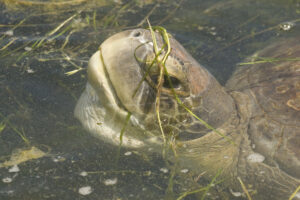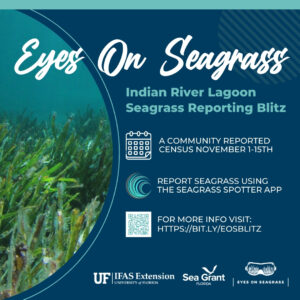 Eyes on Seagrass, a participatory science program dedicated to monitoring the health of Florida’s seagrass population, is excited to launch a new initiative in the Indian River Lagoon! From November 1st to 15th, community members are invited to help collect data on the presence of seagrass in the lagoon.
Eyes on Seagrass, a participatory science program dedicated to monitoring the health of Florida’s seagrass population, is excited to launch a new initiative in the Indian River Lagoon! From November 1st to 15th, community members are invited to help collect data on the presence of seagrass in the lagoon.
The Indian River Lagoon, often referred to as the cradle of the Atlantic Ocean, is home to a vibrant ecosystem featuring lush seagrass beds that provide critical habitats and nurseries for marine species like manatees, sea turtles, and various fish and invertebrates. Seagrass plays a vital role in enhancing water quality by stabilizing sediments, removing nutrients, producing oxygen, and sequestering carbon dioxide.
“Since seagrasses thrive in healthy waters, their presence is an indicator of good water quality in the lagoon. Knowing where seagrass is absent is just as important as understanding where it is present. Monitoring overall seagrass distribution and composition is essential for understanding overall ecosystem health,” says Dr. Lisa Krimsky, Florida Sea Grant Regional Water Resources Extension Agent for the UF/IFAS Southeast District.
Monitoring overall seagrass distribution and composition is essential for understanding overall ecosystem health.
Dr. Krimsky
 Building on the success of the Eyes on Seagrass program in Charlotte and Escambia Counties, anyone in the Indian River Lagoon can now be a part of the collective effort to safeguard the lagoon’s health. The Eyes on Seagrass Blitz will rely on residents to report seagrass using the Seagrass Spotter App. Participants will take photos, use identification guides to determine species, and upload their findings to the designated app. This data will help identify target areas and the types of monitoring needed for future monitoring and survey detailed surveys.
Building on the success of the Eyes on Seagrass program in Charlotte and Escambia Counties, anyone in the Indian River Lagoon can now be a part of the collective effort to safeguard the lagoon’s health. The Eyes on Seagrass Blitz will rely on residents to report seagrass using the Seagrass Spotter App. Participants will take photos, use identification guides to determine species, and upload their findings to the designated app. This data will help identify target areas and the types of monitoring needed for future monitoring and survey detailed surveys.
“After years of seagrass die-off, we’re starting to see areas of regrowth. We want to assess the presence of seagrass, which will inform the monitoring and data collection needed in the next steps of the program,” adds Krimsky.
No special gear is needed—just a smartphone to take photos while you are out on the water with the Seagrass Spotter app downloaded. While you can enter your data on a computer later, using the app is preferred because it geolocates your photos for more accurate data collection.
Whether you are fishing, kayaking, or just soaking up the sun, you can help protect this precious ecosystem. For information on how to get involved in the Eyes on Seagrass Blitz and full participation instruction, click here to learn more.